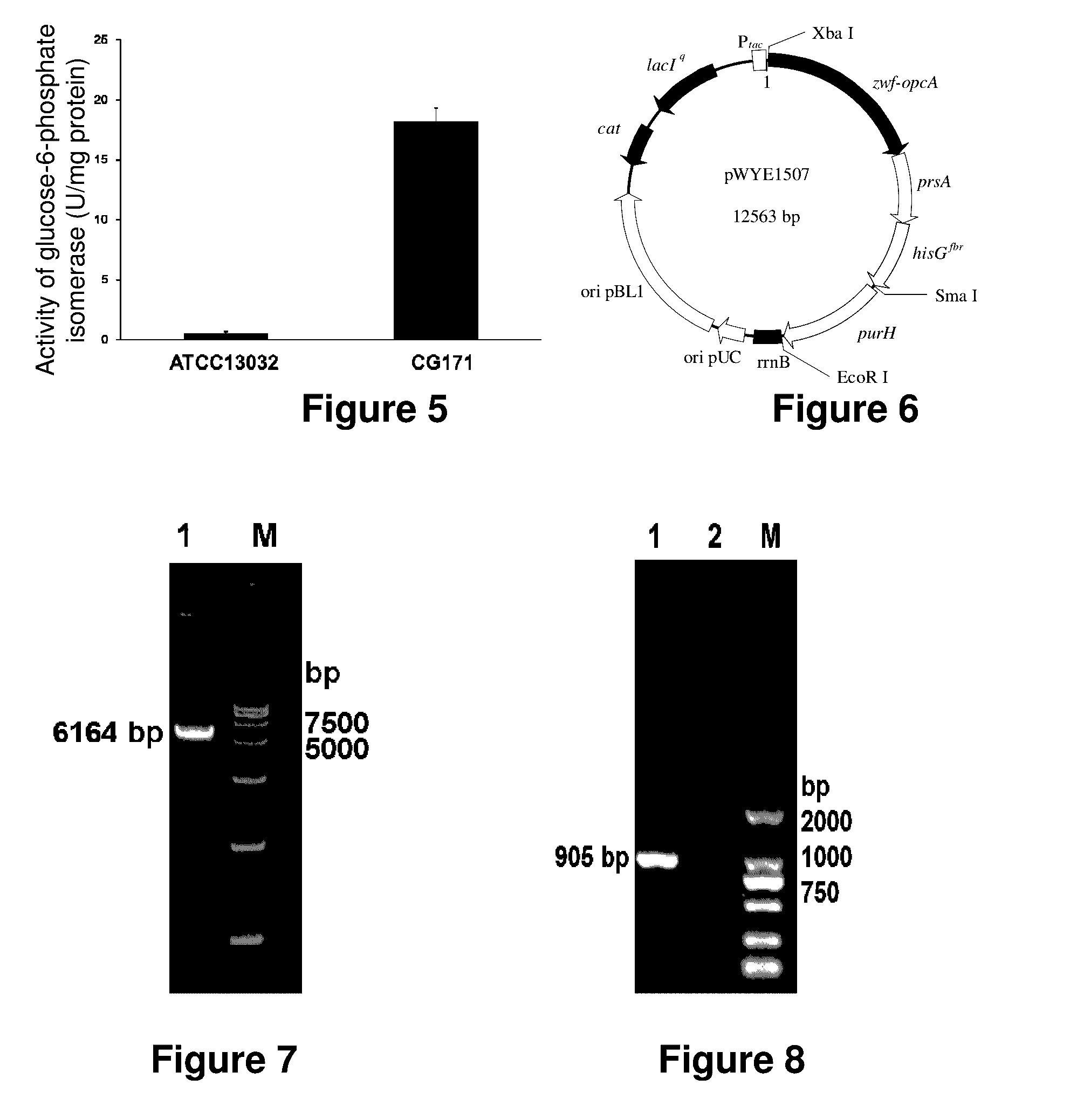Recombinant strain producing l-amino acids, constructing method therefor and method for producing l-amino acids
a technology of l-amino acids and recombinant strains, applied in the field of microbial fermentation, can solve the problems of low yield, low l-histidine production and yield of engineering bacteria, and high production cost and high price, and achieve the effect of improving the yield of l-amino acid(s)
- Summary
- Abstract
- Description
- Claims
- Application Information
AI Technical Summary
Benefits of technology
Problems solved by technology
Method used
Image
Examples
embodiment 1
Obtaining L-Histidine Base Engineering Bacteria CG160
[0106]Based on the previous studies by the inventor, this embodiment carries out the modification of enhancing histidine synthesis to the wild type of Corynebacterium glutamicum ATCC13032 so as to obtain the base bacteria of the aforementioned multi-target modification according to the present invention. First, replace the promoter of hisEG and hisDCB (two operons of histidine synthetic gene) with the endogenous strong promoter PglyA of Corynebacterium glutamicum (as shown by No. 863-1038 nucleotide sequence of 5′ end in Sequence 7 or as shown by No. 752-927 nucleotide sequence of 5′ end in Sequence 8) (Zhang, Y., Shang, X., Lai, S., Zhang, G., Liang, Y., Wen, T., 2012. Development and application of an arabinose-inducible expression system by facilitating inducer uptake in Corynebacterium glutamicum. Appl Environ Microbiol. 78, 5831-5838.). Simultaneously, replace the ribosome binding site (RBS) of the genes hisE and hisD with th...
embodiment 2
Construction of L-Histidine High-Yield Recombinant Bacteria CG171 Containing Plasmid
[0131]In this embodiment, on the basis of the primary engineering bacteria obtained in Embodiment 1, the gene prsA is further over-expressed and the gene hisGfbr (No. 1007-1852 nucleotide sequence in Sequence 4) is also over-expressed. Then knocking-out of the gene pgi (Sequence 13) and over-expression of the gene zwf-opcA (Sequence 2) are combined to obtain the high-yield engineering bacteria CG171.
2.1 Construction of L-Histidine Primary Engineering Bacteria CG176
[0132]The gene prsA encodes the PRPP synthetase (PrsA as shown by Sequence 5. PRPP is the precursor substance for histidine synthesis), enhances the expression of the gene prsA in order to increase the synthesis of the precursor PRPP for histidine synthesis and provides more precursor substances for histidine synthesis.
[0133]On the basis of the base engineering bacteria CG160 obtained in Embodiment 1, both the gene prsA (as shown by No. 15-...
embodiment 3
Construction of L-Histidine High-Yield Engineering Bacteria CG319 Containing Plasmid
[0158]On the basis of the high-yield engineering bacteria CG171 obtained as above, in order to further over-express the gene purH encoding AICAR transmethylase / IMP ring hydrase (PurH as shown by Sequence 16) and hence guide more by-product AICAR increased due to enhanced synthetic pathway of histidine to the synthetic pathway of purine nucleotides, the recombinant plasmid pXMJ19-zwf-opcA-prsA-hisGfbr-purH is constructed and introduced into the primary bacteria CG161 to obtain the high-yield engineering bacteria.
[0159]The primer is designed according to the gene sequence purH of Corynebacterium glutamicum ATCC13032 in Genbank. The genome DAN of ATCC13032 is used as the template and P46 and P47 are used as the primers to carry out PCR amplification on the gene purH (1563 bp) (Sequence 15).
[0160]After double-enzyme digestion of Sma I and EcoR I, the PCR product as above connects with the shuttle express...
PUM
| Property | Measurement | Unit |
|---|---|---|
| Fraction | aaaaa | aaaaa |
| Fraction | aaaaa | aaaaa |
| Fraction | aaaaa | aaaaa |
Abstract
Description
Claims
Application Information
 Login to View More
Login to View More - R&D
- Intellectual Property
- Life Sciences
- Materials
- Tech Scout
- Unparalleled Data Quality
- Higher Quality Content
- 60% Fewer Hallucinations
Browse by: Latest US Patents, China's latest patents, Technical Efficacy Thesaurus, Application Domain, Technology Topic, Popular Technical Reports.
© 2025 PatSnap. All rights reserved.Legal|Privacy policy|Modern Slavery Act Transparency Statement|Sitemap|About US| Contact US: help@patsnap.com


